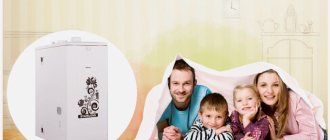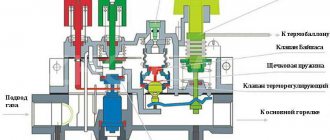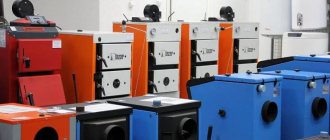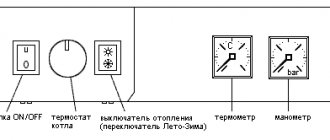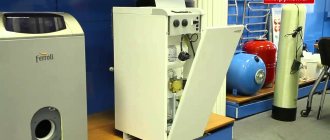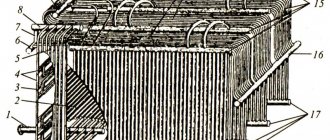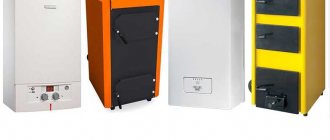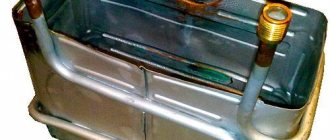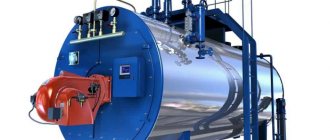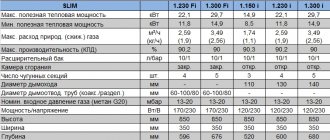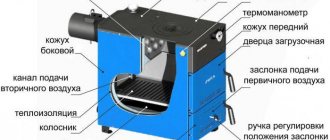The production of most of these types of boilers ceased about 30 years ago, but they will still be in operation for quite a long time. In this regard, as an example, let us consider the design of a cast-iron sectional water heating boiler “Energia-3”. The boiler is assembled from separate sections (Fig. 4.1), connected to each other using liners - nipples, which are inserted into special holes and tightened with coupling bolts. This design allows you to create the required heating surface of the boiler, as well as replace individual sections in case of damage.
Water enters the boiler through the lower pipe, rises up through the internal channels of the section, heats up and leaves the boiler through the upper pipe. Fuel is supplied to the firebox through the door opening. The air required for combustion enters under the grate through air duct 7. Combustion products formed during fuel combustion ( GHGs) move upward, then the direction of GHG flow changes by 180°, i.e. the G1G flow moves down the brick channels and is then directed through a common collection chimney into the chimney.
When moving, the steam generators are cooled, their heat is transferred to the water located inside the sections. In this way, the water is heated 66 to the required temperature. The draft in the boiler is regulated by a gate connected by a steel rope through a block with a counterweight. The rated power of the Energia-3 water heating boilers is 0.35... 0.69 MW, efficiency 73%.
What are hot water boilers used for?
These units are intended for heating buildings with a small area, private houses and town houses. As a rule, such boilers are installed in those settlements where there is no central heating, or, alternatively, the installation of a boiler room is impractical. Be that as it may, the concept of “hot water boilers”, and regardless of the specific design and model, means devices capable of generating thermal energy (due to their technical parameters) when burning a particular fuel, and then directing it to the working fluid (coolant ), which is usually water. And when this water, accordingly, circulates through the heating circuit pipeline, the temperature in the house rises to the required value.
Application area
Powerful models are installed at facilities where large volumes of water need to be heated
The scope of application of hot water boilers extends to all areas of human life. The products are used for heating residential and commercial buildings, covering almost all areas of industry:
Subject to compliance with safety requirements, heating equipment can be installed in the following places:
- apartments, dachas, cottages, private houses;
- warehouses;
- agricultural buildings;
- buildings for keeping animals and poultry;
- storage for vegetables and grain;
- hangars and closed pavilions;
- mines, drilling rigs, artels and settlements located outside populated areas;
- tourist centers and holiday homes.
Design features, classification by temperature and method of execution
The hot water boilers found on the shelves today have a relatively identical design. Significant differences lie in specific manufacturers (they are both foreign and Russian), as well as in the maximum power of the equipment.
If we talk specifically about design features, then from this point of view, boilers can be gas-tube (or, as they are also called, fire-tube) and water-tube. Let's take a closer look at each of the categories.
- Fire tube models. Their distinctive feature can be considered the presence of special tubes through which heated combustion products of energy carriers move. As for the operating principle of such equipment, it is based on the use of automated burners equipped with blower fans. Thanks to the smoke tubes, the water outside them is heated. It is worth noting that such models are almost never used in everyday life.
- Water tube models. They are characterized by special boiling tubes through which the coolant moves. And fuel combustion products are used to heat these tubes. Water-tube boilers warm up quickly enough, you can easily adjust them if the loads change. In addition, the operation of this equipment also involves the possibility of serious overloads. As for the explosion hazard of these boilers, it is at a fairly low level.
Note! All hot water heating devices are also divided according to their temperature level. Thus, the maximum permissible temperature for low-temperature models is 115 degrees, while hot water boilers that overheat water can “boast” a higher figure - about 150 degrees or more.
Note that the low-temperature operating mode provides for fairly economical fuel consumption, but at the same time condensation appears on the surface of the device, which can negatively affect materials in contact with the products of combustion of energy resources. For this reason, extremely stringent requirements are placed on the materials used in the production of boilers.
Units that generate superheated water are characterized by a long service life and high reliability. During operation, they make virtually no noise, and waste emissions are minimal. These units are also equipped with convenient and simple control systems. They are installed quickly and do not require labor-intensive maintenance.
DIY making
It’s easy to make a simple hot water boiler yourself. Here's what you need to consider:
- The choice of firebox material should take into account what type of fuel you plan to use. Coal is characterized by a much higher combustion temperature than wood, so sheets for making a coal boiler firebox should be thicker - thin steel will quickly burn out.
- The ideal material is special heat-resistant boiler steel. In second place is alloyed heat-resistant steel with additions of chromium and molybdenum, for example, grades 12ХМ or 12Х1МФ. If you plan to use ordinary steel, then it should have a grade lower than steel 35. In steels of higher grades, when heated, a hardening effect occurs, as a result of which they become brittle.
Kits consisting of a fan, a temperature sensor and a controller are available for sale (for example, from the Polish company KG Elektronik), with the help of which it is easy to organize forced air supply into the firebox (see above for the description of the operation of a boiler with a fan).
What about the number of contours?
Most of the boilers described in the article (both fire- and water-tube) are double-circuit, but there are also quite a lot of single-circuit units. If the unit has two circuits, then the liquid heated by it will be supplied not only to the heating network, but also to the water supply (after this, of course, it can be used for domestic purposes). Note also that the design of some devices includes special circulators designed to intensify water circulation. Finally, expansion tanks (those of the membrane type) may also be present.
Other differences may relate to the possibility of using different fuels - coal, wood, gas, electric or liquid fuel. Universal units that can truly be called “omnivorous” are becoming increasingly popular today. Regardless of the type of fuel used, any boiler must be equipped with a system that supports combustion processes in automatic mode.
Gas storage water heaters
These devices are structurally and externally reminiscent of electric boilers. The same tank hung on the wall, covered with a layer of insulation, only a gas burner is installed at the bottom, and at the top there is a chimney pipe. A gas boiler works on the same principle, only the heat source is a burner that heats a container of water. The water heater structure is shown in the diagram:
As can be seen in the figure, heating is carried out not only from the burner, but also by removing heat from combustion products. This is achieved through a steel flue with dividers, passing vertically through the container and exchanging heat with the water. The operation of the burner is controlled by an electronic unit, whose task is to extinguish or ignite it when the set temperature is reached or decreased. As usual, to protect the body, the boiler design includes a magnesium anode.
This type of water heater is not very popular due to the difficulties in designing and connecting gas-using installations. In addition, to operate a gas boiler you will need a full-fledged chimney; fulfilling this requirement is not always possible or too expensive.
Main types of hot water boilers
There are many classifications, but often such boilers are divided by purpose, type of fuel used and, of course, by installation method. Let's take a closer look at each of the classifications.
Classification of hot water boilers by type of fuel used
In this regard, devices are divided into four groups, which are given below.
- Solid fuel models. As the name suggests, they use solid energy carriers as fuel - coal, wood, pellets, waste from the wood processing industry, etc. As a rule, they are intended for use in bathhouses and private homes, since they require a sufficiently large area for installation (including space for storing that same solid fuel).
- Liquid fuel models (this can be waste fuel, that is, used engine oil, diesel fuel or fuel oil). As for the application, such water heating boilers are used primarily for heating private houses, and for the same reasons as units of the previous category. The difference is that liquid fuel, in accordance with GOST, must be stored at a certain distance from the heating device so that explosive situations do not arise.
- Gas models. They use liquefied or natural gas as an energy carrier. Typically, they can be used not only in country houses, but also in townhouses and city apartments.
- Electric models. They are usually installed in apartments and not very spacious cottages.
Classification by purpose
Here all devices are divided into only two categories.
- Domestic hot water boilers. Their power can be low or medium (which is much less than that of industrial models, which we will talk about later). They are used in domestic premises that have a small area.
- Industrial hot water boilers. High-power devices in which steam acts as a coolant. That is why they are also called steam boilers. Power is measured in megawatts and averages from 5 to 40 megawatts, which allows you to simply cope with huge volumes of work. Typically, such boilers must be constantly monitored by a specialized operator who has operating charts, as well as detailed instructions for self-repair. In addition, the operator must switch the unit to one or another operating mode, check all elements, etc.
Classification according to the method of heating water
There are also only two varieties, let’s get acquainted with them.
- Boilers with storage tanks. In this case, the water is heated thanks to storage tanks, which, in turn, are filled as it (the water) is used.
- Flow models. In them, the water is heated while passing to a certain temperature from the heating element.
Classification by method of execution (installation)
Water heating devices can be installed on the wall or on the floor.
- Floor models. They are stationary, and differ in that they can operate on any type of fuel.
- Wall models. Wall-mounted devices, as the name suggests, are hung on walls and can operate on gas or electric energy.
Let's look at each of the design options in more detail.
Price
Water heating boilers are characterized by a fairly wide range of prices.
- boiler "Karakan 8-TPE" (power - 8 kW): 12,200 rubles;
- boiler "Sibir KVO 15 TPE" (power - 15 kW): 17,400 rubles;
- boiler "Hephaestus-15" (power - 15 kW): 21,570 rub. (combined, that is, it has a built-in heating element);
- boiler "Karakan 12-TGEV" (power - 12 kW, additionally equipped with a gas burner, heating element, water heating tank): 21,700 rubles.
Imported boilers are much more expensive, for example:
- boiler “BURNit WBS 25” (Bulgaria, 25 kW, can additionally operate on gas, diesel fuel and oil): RUB 86,250;
- Viadrus Hercules U22C-2 (Czech Republic, 11.7 kW): 44 thousand rubles;
Buderus Logano S111-2 (Germany, 12 kW) costs 53,440 rubles.
If there is no gas supply, owners of private houses have a choice - to purchase a solid fuel or liquid fuel boiler. A diesel fuel boiler has a number of advantages, which is why many people prefer this type of heater.
What is a distribution comb and how to install it correctly, read in this material.
Features of floor-standing units
The fuel in this case can be gas, coal, wood or diesel. Boilers must be placed only in a separate, specially equipped room, and if the fuel is liquid/solid, an additional room will be needed for its storage (and with fire-fighting equipment, which are provided for by the provisions of SNiP).
Note! This type of devices can be equipped with automation and control elements. There may also be automatic systems for adjusting water heating, which provides additional convenience. Such systems analyze the temperature inside and outside the room.
In addition, there are special software devices that put the equipment into operating mode based on a preset program.
Boiler equipment
Boilers are the main element of the organization and implementation of the steam power cycle of the heat supply system. The body of low-power low-pressure boilers is made of cast iron, and the body of medium and high-pressure boilers is made of boiler steel.
In order to correctly select the type and number of boilers, technical and economic calculations are performed, taking into account the following factors:
- Maximum and minimum heat load of consumers in winter and summer.
- Distance and diameters of heating networks broken down to each consumer.
- Quality of water and fuel.
- Level of automation of a gas boiler room.
- Boiler room dimensions.
The next most important element of the boiler unit is the burner device, where the process of mixing gas and air and igniting the gas-air mixture to form a torch takes place. The combustion process itself takes place in the combustion chamber
The choice of boiler based on the heat output of the burner must correspond to its power, taking into account the emergency reserve. Good Lemax gas equipment can be purchased in Ishim.
The operation of the burner is ensured by the gas equipment of the boiler room: gas distribution unit or hydraulic fracturing unit, regulators, filters, control devices and a security system. All elements of the gas industry are classified as high-risk objects; their operation is regulated by SNiP II-35-76 “Boiler installations”.
Features of wall-mounted units
If representatives of the previous category require a specially equipped room/extension, then wall-mounted models can easily be installed in the kitchen, bathroom, and so on. Which room to use depends on the specific energy source and convenience considerations. In other words, you yourself must decide where it will be most convenient to use the boiler.
Gas and electricity appliances can be powerful enough to maintain the required temperature in the room, as well as to provide the house/apartment with hot water. The latter in this case is heated in two ways:
- flow-through;
- boiler
Water heating boilers of the first category are equipped with heating elements that are in direct contact with the working fluid. Representatives of the second category involve the use of a storage tank or boiler, where the water is actually heated. In this case, the container is filled as water is used.
Video - How the KVGM boiler works
How to insulate a boiler
There are three options for insulating the boiler:
- Spraying;
- Solid insulation;
- Soft insulation.
Spraying can include any polyurethane foam sealants and foams. In everyday life they are called polyurethane foam. The method is not bad. But there is one drawback - the surface will be uneven and difficult to level.
There are many solid insulation materials. These are polystyrene foam, extruded polystyrene, etc. Their installation will take some time, but the effect will be good. When insulating a boiler in this way, it is necessary to use polyurethane foam to seal the joints.
Soft insulation is mineral wool, foil insulation. Mineral wool retains heat well, but it is best to use thermal insulation with foil. It reflects infrared radiation and retains heat better.
Electric hot water boilers - features and reasons for popularity
Such natures are very popular in Russia. They are produced by many manufacturers - both Russian and foreign. These boilers make it possible to provide housing not only with heat, but also with heated water, regardless of whether there is a centralized hot water supply in your area.
Electric boilers have a simpler design than, for example, gas boilers and do not require regular maintenance. Moreover, they are easy to operate and cannot explode. What can we say about such an important parameter as environmental safety?
Design features of electric hot water boilers
Such devices consist of the following elements:
- heat exchanger (it is a container in which an electric heating element is built);
- automation (necessary to maintain the required temperature in the room, but without direct human participation);
- closet.
Typically, not only ordinary water, but also non-freezing liquid can act as a coolant (this option is more preferable). Such boilers can also be divided according to the type of heating element used.
- Models with tubular heating elements. Such elements are filled with a special conductor that heats up when in contact with electricity. Capable of permanently heating running liquid, but subject to connection to an electrical network. Tubular heating elements are used in cases of combined heating. Who doesn’t know, during the day such systems operate from a heating device using liquid/solid energy or gas, while at night, when the cost of electricity decreases, they keep the house warm using it.
- Models with electrodes. Electrode-type units heat the liquid through an ion flow that forms between the electrodes (this is written in the description). The main advantage is the absence of heating elements, but due to the fact that the most important component of the circuit is the coolant, it must be properly prepared. Salt must be added to the liquid in a certain amount to obtain the desired concentration.
Note! As we have already found out, the main advantage of any electric boiler is its affordable price, ease of installation and operation, small dimensions and weight, and the absence of the need to arrange a separate room.
Production of water heaters PP, GDP, VPE. Delivery to the regions of the Russian Federation and Kazakhstan.
KV-G boilers (gas hot water boiler) (Fig. 71) are produced with a heating capacity of 4 and 6.5 Gcal/h (4.65 and 7.56 MW) instead of TVG boilers. These are direct-flow sectional boilers operating on gas fuel and are a pipe system arranged in one transportable block. The pipe system consists of radiation and convective heating surfaces, similar to shell-and-tube heaters and heat exchangers.
The radiation surface includes four fire screens and a ceiling screen. The pipes of the outer single-light combustion screens and the ceiling along the entire height (length) are connected to each other by metal plates. Each combustion screen is a separate section consisting of straight pipes welded into the upper and lower manifolds.
For a given direction of water movement along the combustion screens, the upper collectors have a blind partition offset from the center (15 and 23 pipes). The combustion screens are connected to each other by bypass pipes.
Rice. 71. Pipe system (part) of the hot water boiler KVG-6.5-150: collectors: 1 - return water inlet; 6 and 9 - rear; 8 and 10 - upper side convective parts; 11 — hot water outlet; 15 — upper ceiling screens; 16 - front; 17 — lower combustion screens; partitions: 2 - made of pipes; 3 - in the pipes of the convective part; 13 - in the upper collectors of the combustion screens; 4 — packages of coils; screens: 5 - convective; 12 - ceiling, turning into front; 18 - lateral; 7 and 14 bypass pipes
The convective heating surface consists of two sections - right and left, each with seven pipes 0 51 x 2.5 mm, welded with one end into the upper and the other into the lower collectors, i.e. they represent the lower and side parts of the heating surface. Four packages of three-pipe coils 0 28×3 mm are welded into the side pipes. To direct the movement of water in the coils, blind partitions are installed in the side pipes.
The radiation surface is separated from the convective surface by a partition made of horizontally placed pipes 0 28×3 mm, connected to each other by metal plates. This partition in the upper part is at the level of the upper coils. Thus, through the space left above, the products of fuel combustion from the radiation heating surface pass into the convective heating surface, heating the coils, and then through the flues and chimney they are removed into the atmosphere.
To clean scale and sludge, all collectors of vertical and ceiling screens have removable hatches at the ends, and the upper collectors of combustion screens have removable hatches on top (one at a time).
Review of some popular models
For clarity, let’s look at the key characteristics and approximate prices of some popular models of hot water boilers. Let us immediately make a reservation that there are quite a lot of manufacturers, and even more so the models themselves, so only a few are described below. For the convenience of site visitors, the information is presented in the form of a small table.
Table. Comparative characteristics of some water heating boiler devices.
| Name, photo | Short description | Average market value, in rubles |
| FORTE BT-S 12 kWt | A solid fuel non-volatile device weighing 115 kilograms and a power of 12 kilowatts. The efficiency is 78 percent, dimensions are 89.5x47x68 centimeters (HxWxD), heating area is from 60 to 110 square meters. | About 27000 |
| An electric water heater, which is distinguished by the presence of a “wet” heating element and a volume of 50 liters. The weight of the product is 15 kilograms. The tank is steel, with polyurethane insulation. | About 5,500 – 6,000 |
| Kospel ekco L1z 21 | An electric boiler intended for use in heating systems in tandem with an indirect heating water heater. Such hot water boilers weigh 16 kilograms, dimensions are 66x38x17.5 centimeters (HxWxD). The outlet water temperature ranges from 40 to 85 degrees, as for the voltage, it should be 380V. | 16000 |
| Solid fuel boiler equipped with a manual firebox. The power indicator (in this case, thermal) is 350 kilowatts, the model is capable of effectively heating rooms with an area of up to 9.45 cubic meters. Does not operate on coal or wood waste. | 210000 |
| The products of this brand are distinguished, first of all, by their versatility. They are not only heating and hot water, but also cooking, and they also operate on both solid fuel (wood) and electricity. | From 23890 |
| Gas-fired water heating boilers with floor-mounted installation. The kit also includes smoke pipes. Consumption is only 21 cubic meters of gas per hour, while the thermal power reaches 200 kilowatts. | From 150,000 to 185,000 |
Note! As you can see, the price spread is quite large, and the specific cost depends on the manufacturer and type of fuel used. In addition, industrial models always cost much more.
Features of installing a hot water boiler
Let's consider the features of installing solid fuel devices, taking into account their prevalence. The procedure itself consists of several stages, and an approximate algorithm of actions is given below.
Stage one . Preparation. You need to prepare the premises (including the one in which the device will be installed). A concrete foundation must be prepared for the boiler, although there are other requirements (minimum distances to other objects, for example).
Stage two . Installation. Obviously, at this stage the boiler itself is installed in its place.
Stage three . Strapping. This stage is rightfully considered the most difficult. It is necessary to connect all communications, as well as additional elements - for example, an expansion tank.
Stage four . Chimney pipe. The next step is to install the chimney.
Stage five . Test run. When everything is ready, you need to check the equipment for functionality. The installation process is described in detail in the file below.
Installation of a hot water boiler. Download file (click on the link to open the PDF file in a new window).
We also recommend watching a video on the topic. That's all, good luck!
Let's understand how an electric boiler works
The tank capacity is surrounded by a heat-insulating layer, on which a decorative plastic or metal casing is installed. Cold water flows through a special pipe installed at the bottom of the device. When using hot water, that is, when the tank capacity is empty, cold liquid is automatically drawn in and gradually heated.
As a rule, the operating circuit of such a device can be supplemented with an element such as a magnesium anode. It is this that helps extend the life of the heating element, since upon contact with hard water, salts are attracted. The result is that scale forms on the anode, and not on the heating element, this can be seen in the section. Replacing the anode is much easier and costs much less.
Gas boilers are installed less frequently than electric and storage boilers, they are cheaper than their analogues, they are not the safest devices for heating water, and besides, they are produced in limited quantities, and there are many difficulties in installing them.
Namely, if there is a need to install the product in an apartment building, then the following is required:
- Coordination with neighbors;
- Installation of a chimney;
- Excellent ventilation;
- Device registration.
The devices can operate on natural gas. The design consists of a water tank, an incoming pipe for supplying cold water, and a pipe for discharging hot water. The body of the product is thick and there is additional space between it and the water tank, due to which the water inside is retained for a long time.
The heat exchange process is carried out through the lower wall, since this is where the combustion chamber and gas burner are located. Heat can be transferred through the inside of the tank from the central channel, through which the combustion product generated in the combustion chamber flows into the chimney.

